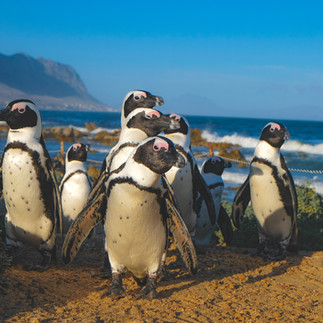Beginner's Guide to Planning a Luxury African Safari
- Heather Vergara

- Jun 22
- 7 min read
Updated: Aug 18

Imagine wide open spaces with fields of green and gold against brilliant blue skies. Imagine wild animals, no matter where you look, and the warmest welcome from guides who feel like family when it’s time to say goodbye. Imagine an African Safari, a life-changing vacation you should move from your dream board to your travel calendar. Here’s what you need to make that happen - the Beginner's Guide to Planning a Luxury African Safari.
Africa offers a world of options on one continent, all of them teeming with wildlife, culture, and stunning landscapes. But all those options can be overwhelming. This guide answers the top 5 questions for planning a luxury African safari.
WHEN are the best times to go on an African Safari?
WHAT are the top destinations for an African Safari?
HOW MANY days are needed for an African Safari?
WHAT is it like on safari?
HOW MUCH does an African Safari cost?
1) WHEN are the best times to go on an African Safari?
There’s no bad time to visit Africa, as there are numerous areas to choose from. We can tailor your itinerary to fit your travel window. Every season has its own magic, but it’s helpful to understand the key differences between dry season and green season.
Africa's Dry Season: May-October
Dry season offers more concentrated wildlife as the animals gather around water sources. This means your game drives are easier because you see tons of wildlife at once, like during the Great Migration. It also means more crowds and higher prices because more tourists visit during the dry season. Temperatures can be high as well.
Africa's Green Season/Rainy Season: November-April
With the rains comes lush landscapes and plentiful water for the animals, so you may have to work harder to find them. However, I was in Kenya in early May, and we didn’t have issues finding animals – they were everywhere! I appreciated the stunningly green landscapes and don’t think I would have been as wowed if everything was brown. Green Season is also calving season. We saw all the babies!
Africa's babies
2) WHERE are the top destinations for an African Safari?
When choosing your safari destination, consider what's most important to you in terms of your experience. For example, do you really want to witness the Great Migration, or would you rather travel when there are fewer crowds? Do you want to see specific wildlife (e.g., gorillas) or is the Big 5 enough for you? Do you want more than just safari - the culture and landscapes of Cape Town, the power of Victoria Falls, or a relaxing beach vacation after your safari? In addition, think about how many stops you're willing to make. Plan on at least 2-3, but some itineraries require more than others.
Immunization requirements are also a consideration for which country to visit. If you stay in one country, Uganda is the only destination that requires the yellow fever vaccination. However, if you move between countries, then the vaccination may be required. No matter which destination you choose, the CDC recommends you check your status on all regular vaccines, including Hep-A, Hep-B and MMR. You may want to consider malaria prevention as well.
The infographic below outlines the key highlights of safari destinations in both Southern Africa and East Africa.
Southern Africa Safari Destinations
Southern Africa encompasses South Africa, Namibia, Botswana, and Zimbabwe/Zambia. In Southern Africa, there is one long dry season, from May to October, when wildlife viewing is at its best. Note: Cape Town’s seasons are reversed vs. the rest of South Africa. Cape Town’s summer is October-March, so if you visit South Africa during dry season and pair it with Cape Town, it will be winter in Cape Town.

South Africa: Cape Town, Kruger NP, and my sweet clients and longtime friends on their recent stay
Namibia: desert landscapes and dark skies
Botswana: water safaris and exclusive camps
Zimbabwe/Zambia: Victoria Falls and extreme sports
East Africa Safari Destinations
East Africa includes Tanzania, Kenya, Rwanda, and Uganda. In Tanzania’s Serengeti and Kenya’s Maasai Mara, you can witness the Great Migration – when wildebeest and zebra cross the Mara and Grumeti Rivers facing crocodiles and big cats. While the migration is year-round, the river crossings happen from June–October.
East Africa has two rainy seasons and two dry seasons.
Dry: January–March and June–October
Rainy: March–May and November
I visited four different safari camps in Kenya in early May, including Amboseli National Park, Lewa Conservancy, Loisaba Conservancy, and the Maasai Mara National Reserve. The only rain we experienced was on the Mara.

Tanzania: The Great Migration, climb Mt. Kilimanjaro, beaches of Zanzibar
Kenya: Mt. Kilimanjaro views, The Great Migration, Maasai tribe
Rwanda: Gorilla trekking, volcanic landscapes
Uganda: Gorilla trekking, extreme sports, yellow fever vax required
3) HOW MANY days are needed for an African Safari?
The amount of time you need in Africa depends on what you want to do, but I suggest experiencing at least two safari camps, with a minimum of three nights at each. If you also want to do more than safari - e.g., Cape Town, Victoria Falls, or the beach - then you’ll need several nights for that stop, too. Assuming you live in the United States, travel time plus the time change adds 3 days to your trip – 2 days on the front end and 1 day on the return.
If you can be away for 10 days, then you could do 2 safari camps.
If you can be away for 2 full weeks, then you could do 2 safari camps + a non safari stop like Cape Town or a Zanzibar beach.
4) WHAT is it like on an African Safari?

You’ll fly a small plane from your arrival city to your first safari camp. We took a private charter flight from Nairobi on Scenic Air Safaris, which was quite luxurious with red carpet, leather seats, and a champagne toast at our first stop. Guides from camp will meet you at the airstrip with refreshments and a warm welcome, and you’ll start your first game drive on the way to camp. Animals are everywhere, so anytime you’re in the truck, it’s a game drive! Be prepared for wildlife that's so close you can almost touch it! In fact, a guest in the truck in front of us actually reached out of the window to pet a lion - which is NOT allowed or recommended!
The guides speak excellent English and are warm, personable, and incredibly well-trained. They will educate you, entertain you, and keep you safe! By the end of your stay, your guide will feel like a friend, as will the other travelers in your group.
Safari camps are all-inclusive, offering game drives plus all meals, as well as sundowners and breakfast in the bush. Some camps also include additional activities, while others charge a fee. While no day is the same because you never know what animals you will find, a day in the life on safari looks like this.
Early morning wakeup with a light breakfast snack before a sunrise game drive - prime time for spotting wildlife because they're out hunting.
Breakfast in the Bush - beautiful views and freshly made omelets, pastries, fruit, and coffee. The camp sets up a “loo with a view” with an actual bush toilet, so squatting in the grass isn’t necessary.
Game drive on the return to camp
Lunch and downtime. Nap, lounge by the pool, indulge at the spa, or book an activity
Afternoon tea and game drive
Sundowner in the bush - Mini sundowners were set up by the guides on the back
of the trucks with cocktails, wine and beer, and snacks. Major sundowners (once per stay) were set up on top of the ridge and included chairs, a bonfire, appetizers, and a full bar. The owners of the camp often joined us for the major sundowners.
Back to camp for “bush TV” (firepit), drinks, and late dinner
Early bedtime
A day in the life on safari: Sunrise game drives, breakfast in the bush, animals so close you can almost touch them, Maasai village visit, sundowners, and an after-dark escort to bed.
The food, drinks, and service at luxury camps are outstanding. You won't go hungry! You choose your dinner menu over lunch, and you can make special requests, so even picky eaters will be happy.
Our "tents" were luxurious and seemed more like a house than a tent, but the level of luxury will depend on your budget. If the camps are protected by electric fencing, you can walk to your tent for bedtime. If the camps aren’t protected, then security will escort you to your tent after dark. I much preferred the fenced-in camps, because it was spooky walking in the dark, knowing animals could be lurking nearby. At our last camp in the Maasai Mara, they said hyenas were spotted the night prior in camp, and elephants were sleeping in the bush right beside our tent!
Top: Fresh and creative made-to-order culinary options
Bottom: (1) Tortilis Camp at Amboseli, (2) Lewa Safari Camp, (3) Loisaba Tented Camp, (4) Sand River Maasai Mara
Safari downtime activities include: pool, spa, bush walk, horseback riding, camel riding, Maasai village visit, hot air balloon, anti-poacher education, wildlife rehabilitation centers, and more!
In addition to game drives, I enjoyed chill time at the pool, a hot air balloon ride over the Maasai Mara, my first camel ride, a warm welcome from a Maasai tribe, anti poacher education with sniffer dogs, and a visit to an elephant orphanage
5) HOW MUCH does an African Safari cost?
Cost depends on the level of luxury you desire, your destination, and the experiences you wish to have. A rule of thumb for a luxury safari in Africa is a minimum of $1,000 per person per night in destination. This includes almost everything except international airfare and travel insurance.
Loisaba Tented Camp is a dream come true. From the moment we walked into this spectacularly beautiful safari camp, we felt like family.
Show Them the World works with the best-of-the-best in Africa, so when you're ready for the experience of a lifetime, we're ready to help make it happen!

Heather Vergara is a former PepsiCo marketing executive who left the corporate world to be a Mom and never found her way back. Instead, she focused on her passion for travel and adventure and created Show Them the World, a travel concierge service for busy families longing to reconnect and see the world together. She's now a Million Dollar Advisor with Gifted Travel Network, a Virtuoso agency. Heather has helped hundreds of families experience Hawaii, Alaska, Costa Rica, the Caribbean, Italy, France, Greece, England, Croatia, Spain, Portugal, Ireland, Africa, Iceland, National Parks, and more to come!
Heather has an MBA in marketing from Indiana University, a Digital Marketing Executive Education certificate from Columbia University, and a BA in Journalism from the University of North Carolina at Chapel Hill. She lives with her husband, two kids, and two furry dogs in Zionsville, Indiana.
.png)







































































































































Comments